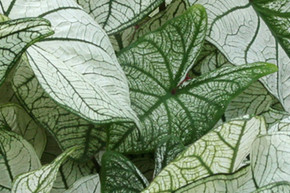

June is a fun time of year! Different crinum and rain lilies continue to pop into bloom, but the staples that keep texture and color all the time right now are our caladiums. I've come to appreciate their function and form and what it brings to our garden. We have a new bright pink selection called 'Pinky Swear'. Whether in pots, borders, or circling a tree, the striking whites, pinks, and reds are a beautiful addition to the garden.
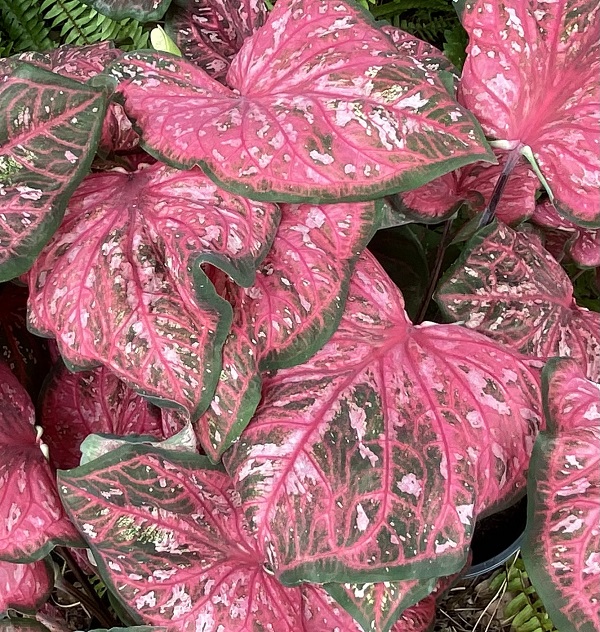
Caladium is often called "Angel Wings" or in other areas they have been called "Elephant Ears". You understand why they are called these the moment you look at them. Caladiums are actually grown for their foliage or leaves instead of their blooms. The beautiful heart-shaped leaves in varying colors create a great accent to your garden whether you are using them as a landscape focus or for pops of color around your garden or even in containers. Caladium mix well with other plants as they add color and texture to your garden.
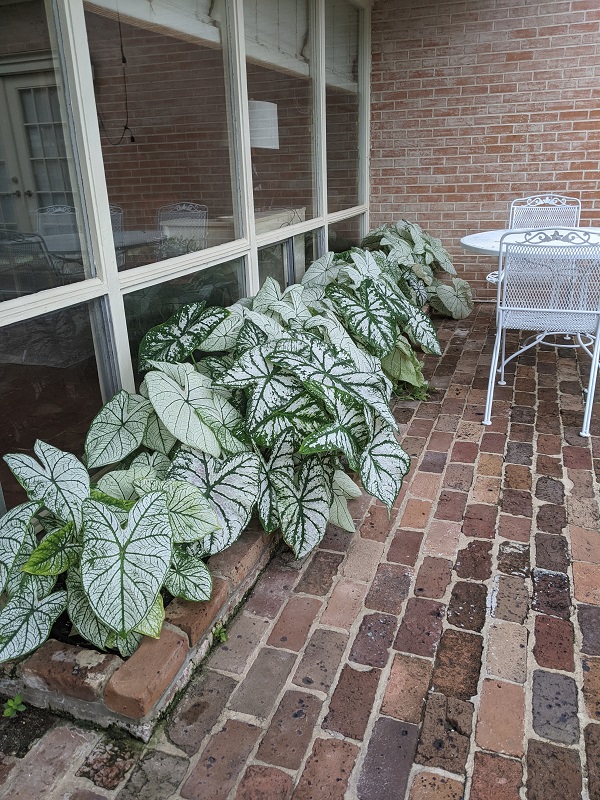
These three (3) tubers are considered #1 size which means they are 1 1/2 - 2 1/2 inches in diameter. The larger the bulb the more "eyes" it has. Each eye produces a leaf. The more eyes equals the more leaves.
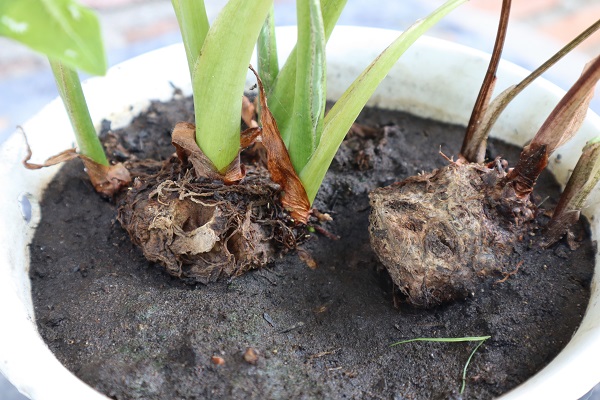
The 'Pinky Swear' Caladium is considered a strap-leaf variety which simply means that the stem will grow 6-15 inches long before producing its heart-shaped leaf that is about the size of an adult hand. The Pinky Swear is a bubblegum pink color with blotched leaves. The leaves have red veins and are bordered in green.
Planting: Caladium tubers are fun to plant because they don't care how you plant them. You can plant them upside down (mainly because it is a little hard to tell the top from the bottom on a large tuber.) Plant with 1/2 - 2 inches of soil above the bulb and about 6-10 inches apart. When you first plant you caladium tuber, water occasionally. They will rot if given too much water. Once the leaves begin to appear be sure to give it more water. Every couple of days is great. It is best to water early in the morning or late evening so that the sun won't burn the fragile leaves.

Winter:
Do I have to dig them? For the first few years that I planted caladiums in our garden, I would continually dig them up each fall assuming that they were only annuals. Then a seasoned landscaper asked me "Why are you doing that? They are perennials here." I never stop learning! Sure enough, they not only come back every year for us in our Zone 8 garden, they get better and better each year. I was under the impression that they could only be grown in a small region of the United States. That is not true! They might grow better in different parts of the US, but they are definitely perennials worth keeping in the garden.
Here in zone 8, we have had a couple of winters now with very cold temperatures that lasted for days. We found that our caladiums planted out in the open didn't survive the winter freezes; however, those planted up next to the house did and are doing great.
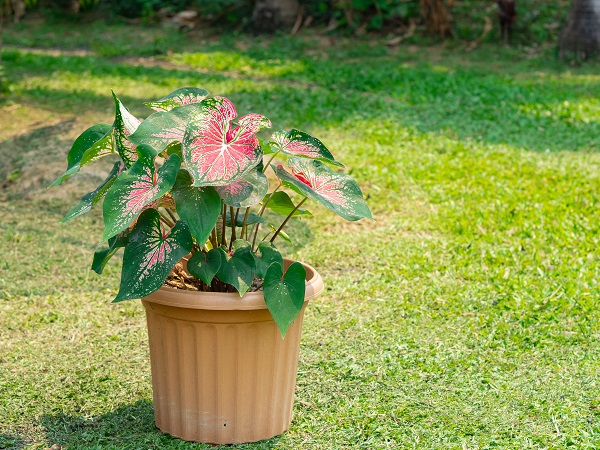
Caladiums in Pots: It doesn't matter if the location is dark or not. The most important thing about storing the bulbs is that they have a temperature of at least 65 degrees. There are a couple of different things that you can do. 1. You can dig the bulbs out, wash, let them dry completely, and then store them in a dry location. Do NOT store them in an airtight container! They will mold and rot. 2. But the easier thing to do is simply leave the bulbs in the pots over the winter if you have room for them. You can stack the pots on top of each other after the foliage has died down and move into a basement or closet. Once the temperatures are consistently 65 degrees at night, you can move the pots outdoors and start watering them again.
June is a fun time of year! Different crinum and rain lilies continue to pop into bloom, but the staples that keep texture and color all the time right now are our caladiums. I've come to appreciate their function and form and what it brings to our garden. We have a new bright pink selection called 'Pinky Swear'. Whether in pots, borders, or circling a tree, the striking whites, pinks, and reds are a beautiful addition to the garden.

Caladium is often called "Angel Wings" or in other areas they have been called "Elephant Ears". You understand why they are called these the moment you look at them. Caladiums are actually grown for their foliage or leaves instead of their blooms. The beautiful heart-shaped leaves in varying colors create a great accent to your garden whether you are using them as a landscape focus or for pops of color around your garden or even in containers. Caladium mix well with other plants as they add color and texture to your garden.

These three (3) tubers are considered #1 size which means they are 1 1/2 - 2 1/2 inches in diameter. The larger the bulb the more "eyes" it has. Each eye produces a leaf. The more eyes equals the more leaves.

The 'Pinky Swear' Caladium is considered a strap-leaf variety which simply means that the stem will grow 6-15 inches long before producing its heart-shaped leaf that is about the size of an adult hand. The Pinky Swear is a bubblegum pink color with blotched leaves. The leaves have red veins and are bordered in green.
Planting: Caladium tubers are fun to plant because they don't care how you plant them. You can plant them upside down (mainly because it is a little hard to tell the top from the bottom on a large tuber.) Plant with 1/2 - 2 inches of soil above the bulb and about 6-10 inches apart. When you first plant you caladium tuber, water occasionally. They will rot if given too much water. Once the leaves begin to appear be sure to give it more water. Every couple of days is great. It is best to water early in the morning or late evening so that the sun won't burn the fragile leaves.

Winter:
Do I have to dig them? For the first few years that I planted caladiums in our garden, I would continually dig them up each fall assuming that they were only annuals. Then a seasoned landscaper asked me "Why are you doing that? They are perennials here." I never stop learning! Sure enough, they not only come back every year for us in our Zone 8 garden, they get better and better each year. I was under the impression that they could only be grown in a small region of the United States. That is not true! They might grow better in different parts of the US, but they are definitely perennials worth keeping in the garden.
Here in zone 8, we have had a couple of winters now with very cold temperatures that lasted for days. We found that our caladiums planted out in the open didn't survive the winter freezes; however, those planted up next to the house did and are doing great.

Caladiums in Pots: It doesn't matter if the location is dark or not. The most important thing about storing the bulbs is that they have a temperature of at least 65 degrees. There are a couple of different things that you can do. 1. You can dig the bulbs out, wash, let them dry completely, and then store them in a dry location. Do NOT store them in an airtight container! They will mold and rot. 2. But the easier thing to do is simply leave the bulbs in the pots over the winter if you have room for them. You can stack the pots on top of each other after the foliage has died down and move into a basement or closet. Once the temperatures are consistently 65 degrees at night, you can move the pots outdoors and start watering them again.